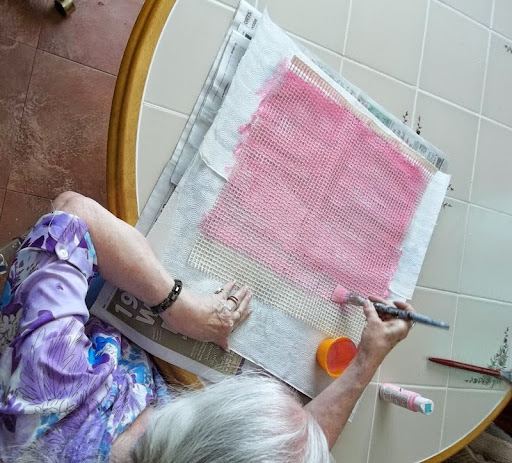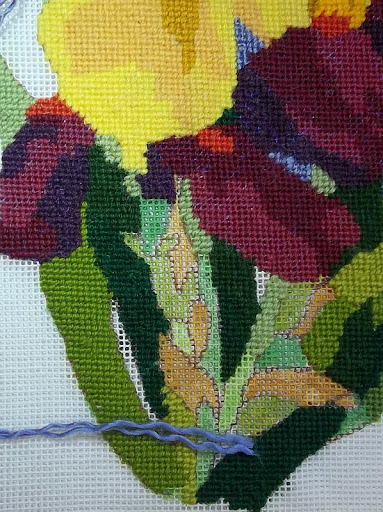 |
| Bargello stitch sampler from April 10, 2014 post |
Last weekend a regular reader reminded me that I had promised articles about all-over bargello designs and optical illusions done in needlepoint. She asked when she was likely to see them. I told her I would get started on the all-over designs right away. Here is the first article on the subject that some of you have awaited patiently (or impatiently). To follow along, you will need a piece of plastic or fabric needlepoint canvas, several colors of yarn, a tapestry needle and scissors. I will be referring to a sampler of stitches from the April 10, 2014, post. You can click on the sampler to see the stitches enlarged. We will begin with the sample in the lower left-hand corner. We will be making rows of these “peaks” and “valleys” stitches, but ours will be all the same height.
I'm going to make the sample on #7 plastic canvas with acrylic yarn so that the stitches will be easy for you to see. I'm using a light, a medium, and a dark green, in that order. I'm working from left to right, but you may work from right to left if you like. I start in a square of mesh at least 9 down from the top edge. I bring my needle through from the back of the canvas, holding the last inch and a half (3 ½ to 4 cm) against the back of the canvas with a couple of fingers, and work the stitches over it to secure it. My first stitch goes directly upward, skipping 3 of the bars (plastic canvas) or threads, and going down in the next square of mesh. (Remember that we count this way; we do not count the squares themselves.) The next stitch begins and ends 1 square of mesh higher than the first stitch. I continue in this way until I have 7 stitches and have reached the top of the first “peak”. The next stitch will begin and end 1 square of mesh lower than the top stitch. I will continue in this way until I reach the “valley” (6 stitches) and repeat the pattern at least 3 times. This lightest row is your base row. All “peaks” and “valleys” should begin and end in the same rows of mesh. Check with a straight-edge if you are not sure. If you make a mistake here, you will carry it throughout the design.
 Secure your base row by running an inch and a half of your yarn under completed stitches and cutting it close to the back of the canvas. I worked the second row with the medium color and the third row with the dark color. No canvas is left bare. The tops of the second row of stitches share the same squares of mesh as the bottoms of the first row of stitches. I continued until I had used the lightest color 4 times. I then stitched partial rows of the other colors to complete the rectangle and cut away the excess canvas. With a heavy white yarn, I top-stitched over the top and bottom stitches of the light-colored row each time it appears in the pattern. These stitches really stand out against the darker background. This would be an attractive pattern for place-mats, book covers, tote bags or similar items.
Secure your base row by running an inch and a half of your yarn under completed stitches and cutting it close to the back of the canvas. I worked the second row with the medium color and the third row with the dark color. No canvas is left bare. The tops of the second row of stitches share the same squares of mesh as the bottoms of the first row of stitches. I continued until I had used the lightest color 4 times. I then stitched partial rows of the other colors to complete the rectangle and cut away the excess canvas. With a heavy white yarn, I top-stitched over the top and bottom stitches of the light-colored row each time it appears in the pattern. These stitches really stand out against the darker background. This would be an attractive pattern for place-mats, book covers, tote bags or similar items. Next, I repeated the pattern with tapestry wool on #14 needlepoint canvas, an action which – by itself – will greatly change the dimensions of the pattern. This time I used only 5 stitches for each “peak”, instead of 7. My colors were closely related oranges in a dark/medium/light/medium sequence, and the top-stitching was done in a dark brown. This time I top-stitched both the dark and light rows, but not the medium ones. Each time you use needlepoint canvas, you are creating a fabric. This one is a herringbone-like fabric which would be nice for small items like cellphone covers, but could equally be used for a garment like a vest. You can top-stitch all the rows and get a fabric with vertical stripes. When working with dark colors, I usually top-stitch in white or a light color; when working with light backgrounds, a black or a dark color. Medium colors may require either dark or light accents. Experiment by placing strands of different colors of yarn on top of your finished background to find an effect that pleases you.
Next, I repeated the pattern with tapestry wool on #14 needlepoint canvas, an action which – by itself – will greatly change the dimensions of the pattern. This time I used only 5 stitches for each “peak”, instead of 7. My colors were closely related oranges in a dark/medium/light/medium sequence, and the top-stitching was done in a dark brown. This time I top-stitched both the dark and light rows, but not the medium ones. Each time you use needlepoint canvas, you are creating a fabric. This one is a herringbone-like fabric which would be nice for small items like cellphone covers, but could equally be used for a garment like a vest. You can top-stitch all the rows and get a fabric with vertical stripes. When working with dark colors, I usually top-stitch in white or a light color; when working with light backgrounds, a black or a dark color. Medium colors may require either dark or light accents. Experiment by placing strands of different colors of yarn on top of your finished background to find an effect that pleases you. Our next all-over pattern is derived from the group in the upper right-hand corner of the stitch sampler. The pattern consists of 2 stitches over 2 bars or threads, followed by 2 stitches over 4 bars or threads, repeated across the sample. The second row uses 2 stitches over 4 bars or threads, then 2 stitches over 2 bars or threads, repeated across the work. The rows fit together like the cogs on wheels. (See the examples on the sampler.) I used a seafoam green, a sky blue, and an aquamarine. Each color will sometimes begin with the 2 short stitches and sometimes with the 2 long ones. Once I had an adequate sample, I filled in the partial stitches at the top and bottom of the work. Then I top-stitched with white yarn, making a short stitch over the vertical bar between the stitches in each pair, across the top and the bottom of each 2-stitch group. I used straight horizontal stitches. You can back-stitch these, but it requires both more yarn and more time to do so. The “loops” that you think you see in the pattern are an optical illusion. Turn your completed sample over and you can see another neat pattern. Can you figure out how to make this appear on the front of the sample, rather than the back?
Our next all-over pattern is derived from the group in the upper right-hand corner of the stitch sampler. The pattern consists of 2 stitches over 2 bars or threads, followed by 2 stitches over 4 bars or threads, repeated across the sample. The second row uses 2 stitches over 4 bars or threads, then 2 stitches over 2 bars or threads, repeated across the work. The rows fit together like the cogs on wheels. (See the examples on the sampler.) I used a seafoam green, a sky blue, and an aquamarine. Each color will sometimes begin with the 2 short stitches and sometimes with the 2 long ones. Once I had an adequate sample, I filled in the partial stitches at the top and bottom of the work. Then I top-stitched with white yarn, making a short stitch over the vertical bar between the stitches in each pair, across the top and the bottom of each 2-stitch group. I used straight horizontal stitches. You can back-stitch these, but it requires both more yarn and more time to do so. The “loops” that you think you see in the pattern are an optical illusion. Turn your completed sample over and you can see another neat pattern. Can you figure out how to make this appear on the front of the sample, rather than the back? Finally, I did the same pattern on #10 canvas – finer than the #7, but not as fine as the #14. Because of the strong color contrast, the “toothed” effect of the pattern is more obvious. Technically, this one is not top-stitched, since the metallic copper yarn is just woven over the short stitches and under the long ones. I would only use metallic accents on decorative items which would not get any hard use. Besides metallic yarns, there are metal threads, threaded crochet cotton, metallic braid and rick-rack, ribbons, and shiny metallic-colored embroidery flosses.
Finally, I did the same pattern on #10 canvas – finer than the #7, but not as fine as the #14. Because of the strong color contrast, the “toothed” effect of the pattern is more obvious. Technically, this one is not top-stitched, since the metallic copper yarn is just woven over the short stitches and under the long ones. I would only use metallic accents on decorative items which would not get any hard use. Besides metallic yarns, there are metal threads, threaded crochet cotton, metallic braid and rick-rack, ribbons, and shiny metallic-colored embroidery flosses.
The colors you choose for a pattern have a tremendous effect on its appearance. For example, look at the two identical stitch patterns below, done in a monochromatic color scheme and in a wild, rainbow-colored one. What a difference! Have fun playing with patterns!








